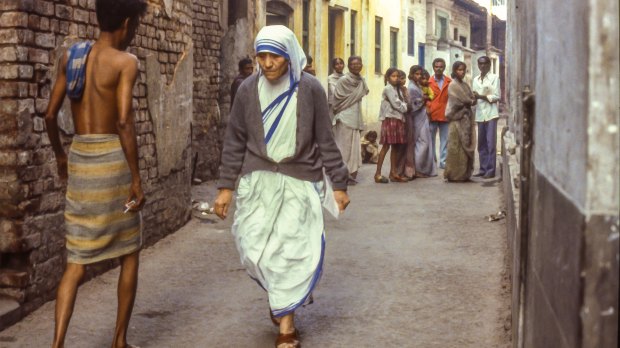As someone who has worked in Catholic media for years, David Naglieri was well aware of Mother Teresa’s story. But compared to what he learned when he made a documentary about her to commemorate the 25th anniversary of the saint’s death, his knowledge, he concluded, had been somewhat superficial.
By the time Mother Teresa: No Greater Love made its theatrical debut in mid-September, Naglieri had come to a deeper appreciation of St. Teresa of Kolkata in at least three significant ways.
1For lonely youngsters
One of those aspects has to do with the youngest generations, who are certainly not hurting materially, even though the world will remember Mother Teresa as an aged woman with deep facial wrinkles, whose focus was on the poorest of the poor.
“I think that when you look, for example, at [widespread use of] social media, and you look at people becoming more and more isolated — we’re seeing increased loneliness, increased rates of depression among our young — and I think often that’s a symptom of this spiritual poverty that Mother Teresa diagnosed,” Naglieri said in an interview. “She would often say that the greatest poverty was the spiritual – the loneliness that she would notice in the western countries that were materially rich.”
Mother Teresa: No Greater Love will be shown in theaters nationwide on Monday and Tuesday, October 3 and 4. It seeks to introduce the saint to a new generation, said Naglieri, who wrote and directed the film. The one-hour-55-minute documentary, a media project of the Knights of Columbus, intersperses dramatized bits of Mother Teresa’s biography with visits to various locations of the Missionaries of Charity, the order of nuns, brothers and priests that she started. As the order works worldwide, the documentary had to cover a lot of territory.
“We were in Tijuana, Mexico, filming their work with migrants and refugees,” said Naglieri, producer and media manager at the Knights of Columbus. “We traveled to Rio De Janeiro, and the work outside of Rio — Crackland, it’s called — where they work with crack addicts and drug addicts and drug dealers, in abject squalor, who live along these train tracks, not even allowed into the favelas, the slums of Rio De Janeiro. We had drone cameras following [the Missionaries of Charity nuns] as they took boats down in the Amazon River basin and would bring the Eucharist and catechize the children of these Indigenous tribes with no contact with the outside world. We were in Nairobi, Kenya, filming in the slums there, where they work with severely disabled children. These images show the ongoing work and mission of Mother Teresa reflected in the lives of the Missionaries of Charity.”
2Healing the mercy vs justice “division”
The other lessons Naglieri, an Emmy Award-winning filmmaker, took away from working on the project also spoke to the experiences of Christians in the relatively affluent West, rather than the poorest of the poor. The divisions the Church is dealing with right now, he said, have to do with the tensions in attitudes towards justice and mercy. Mother Teresa set a good example from which Christians can benefit in that regard, he said.
“She’s a great witness for this generation, in the sense that she was this perfect blend and this perfect integration of justice and truth on one side and love and mercy on the other,” the filmmaker said. “I think a lot of the conflicts that exist within the Church, and also I think within the greater society, often come down to … where you stand on that line between justice and love, mercy and the truth.”
Mother Teresa was certainly not someone who shied away from speaking hard truths. The film shows parts of her Nobel Peace Prize acceptance speech in 1979.
“The greatest destroyer of peace today is the cry of the innocent unborn child. For if a mother can murder her own child in her own womb, what is left for you and for me to kill each other?” she said, as hundreds of influential and well-dressed people sat in the audience in Oslo. “To me the nations who have legalized abortion, they are the poorest nations.”
But, according to Naglieri, many of the people interviewed for his film said that Mother Teresa’s greatest virtue was mercy.
“She was completely nonjudgmental — not in a relativistic sense, but in the sense that she perfectly reflected the mercy and the love of God,” he said. “It’s that love that touched so many people’s lives. We have a lot of testimonials in the film, from people like Jim Wahlberg, the older brother of [actor Mark Wahlberg. Jim Wahlberg] served a six- to nine-year prison sentence for robbery, who was a drug addict, who was not a person of faith, and who had a perception of God as being out to get you — this negative perception of a scary God. And when he met Mother Teresa, when she spoke to the prisoners, he felt that he saw for the first time the face of a merciful God. Her words deeply touched him and led him to begin inquiring about Jesus, inquiring about the faith, and ultimately he comes back to the Catholic faith and goes on to become a Catholic evangelist and speaker.”
“So I think she’s very much a saint for our time in many ways,” Naglieri continued. “She really presented this perfect example of how we can uphold the Church’s truths, how we can be strong, how we can be courageous, but at the same time in a perfectly balanced fashion reflect God’s mercy and God’s love.”
3Each home a tabernacle
Finally, her example — still carried out by the Missionaries of Charity in convents throughout the world — of Eucharistic devotion is one that speaks to the Church in the United States, now entering into a multi-year “Eucharistic Revival” project.
“Mother Teresa believed very strongly that the same Christ hidden in the Eucharist is the Christ hidden in the poor,” Naglieri said. “And the two were inextricably intertwined in her faith and spirituality.”
The film points out that Mother Teresa wanted her convents to be known as tabernacles — where Jesus Christ lives in the Eucharist and from where His love flows into the streets to heal the poor and broken.
Said Naglieri, “Mother Teresa is a saint for our times. I think her message of finding Jesus in your neighbor, of demonstrating the mercy of God to all you encounter, the commitment to serve the poorest of the poor, the humility and grace with which she served and followed her mission, all the aspects of her life are very applicable to our generation.”



